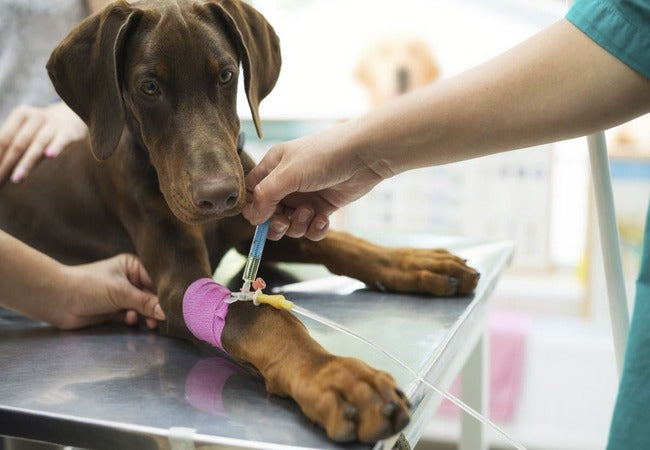Vet‑Approved 2025 Guide: Dog Elective Surgery – What You Should Know Before You Say Yes 🐶✨💉

In this article
Vet‑Approved 2025 Guide: Dog Elective Surgery – What You Should Know Before You Say Yes 🐶✨💉
By Dr. Duncan Houston BVSc
Elective surgery—non-emergency procedures like spay/neuter, benign mass removal, or dental cleanings—can improve your dog’s health and comfort. But before you say yes, it's crucial to understand why the procedure is recommended, what it involves, the pros vs. cons, and how to support your dog's safe journey through recovery. In this fully detailed guide, Dr. Duncan Houston BVSc walks you through every step of elective surgery in 2025, with practical support tips using Ask A Vet to give you peace of mind. 🩺🐾
🔍 What Is Elective Surgery?
Elective surgery refers to any non-urgent procedure that can be scheduled in advance—unlike emergency surgeries such as foreign-body removal or internal bleeding. Examples include:
- Spay and neuter
- Dental extractions
- Benign skin or soft tissue mass removal
- Orthopedic procedures like patellar luxation correction or TPLO
These are performed to improve health, comfort, or quality of life.
⚖️ When Should You Choose Elective Surgery?
Vets recommend elective procedures when benefits outweigh risks and potential complications, and when waiting could cause harm or worsen the condition:
- Spay/neuter: Prevents reproductive diseases; timing varies based on breed and development.
- Dental extractions: Remove diseased teeth to reduce pain and infection risk.
- Mass removal: Growths that are enlarging, uncomfortable, or cosmetically concerning.
- Sports/orthopedic procedures: Correct structural issues that impair mobility or cause pain.
🆚 Risks vs. Benefits
Elective doesn’t mean risk-free. Careful consideration is vital:
✔️ Benefits:
- Prevents disease or pain (e.g., pyometra, joint degeneration)
- Improves function or comfort (e.g., mobility, oral health)
- Covers cosmetic or behavioral concerns
❗ Risks:
- Anesthetic complications
- Infection, bleeding, delayed healing
- Unexpected findings (like malignancy in a mass removed)
Discuss your dog’s age, breed, health status, and lifestyle with your vet to weigh risk vs. reward.
🩺 Preparing for Surgery
Proper preparation improves safety:
- Pre-op exam: Full physical, bloodwork, urine, imaging for older or at-risk dogs.
- Fasting: No food for ~12 hrs; water as directed—older pets or brachycephalic dogs may need different schedules.
- Home readiness: Quiet, warm recovery area, support harness, non-slip surfaces, e-collars or soft bodysuits pre-fitted.
- Mental prep: Positive visits, gentle handling, and pre-op enrichment help reduce stress.
🛠 How Surgery & Anesthesia Work
Elective procedures are performed under anesthesia, with multi-modal protocols tailored to each dog. Your surgical team should:
- Monitor ECG, oxygen, blood pressure, CO₂, and temperature during and after surgery.
- Administer IV fluids and maintain warmth using blankets or fluid warmers.
- Have an experienced veterinarian or tech dedicated to monitoring anesthesia, with immediate action ready for any changes.
🛌 Post-Surgical Recovery and Aftercare
How you care for your dog post-op plays a big role in recovery:
Immediate (0–24 hrs):
- Observation until fully awake and stable
- Small sipping of water; light food when fully conscious
Short-term (1–2 weeks):
- Restrict exercise—no stairs, jumping, off-leash play
- Use cones or recovery suits to prevent licking
- Monitor incision daily for redness, swelling, discharge
- Follow pain and antibiotic meds as prescribed
- Recheck appointments—usually 10–14 days post-op
Long-term:
- Gradually resume normal activity after the incision heals
- Weight control and muscle strengthening
- Monitor for recurrence if layers of tissue or masses were removed
🛠 Smart Questions to Ask Your Vet
- ✅ Is this procedure elective or essential?
- 🧠 What are anesthesia risks for my dog’s age/breed?
- 🏥 Who will monitor anesthesia and how?
- 📋 What pre-and post-op care do you provide?
- 💰 What are the total costs, including lab work and follow-ups?
🛡️ Supporting Your Dog with Tools & Care
- Ask A Vet: Remote check-ins, medication reminders, wound photo reviews 🩺📱.
📞 When to Contact the Vet After Surgery
- Fever, vomiting, diarrhea, or refusal to eat/drink >24 hrs
- No urination or bowel movement within normal timeframe
- Heightened redness, swelling, bleeding, or odor at the incision
- Signs of pain like whining, shaking, decreased mobility
🏁 Final Thoughts
Elective surgery can be a life-enhancing decision when done thoughtfully and with comprehensive support. From early diagnosis and surgical planning to careful recovery and supportive care tools, you're empowered to give your dog the best outcome. With trusted resources like Ask A Vet, you’ll navigate the process with confidence, ensuring your pup feels safe, comfortable, and loved every step of the way. 🐾❤️






